IBM Simon is the world's first smartphone. What's inside?
Foreword
Somehow I got into the hands of some entertaining device - an IBM Simon mobile phone. It is interesting that it is the first smartphone in the world. That is, the functions of the phone combine the PDA, touch screen and the ability to install third-party applications.
After studying the old archives, this device seemed to me quite interesting. As usual, in these old articles the internal structure was very superficially painted, so after removing a small layer of dust from my set of screwdrivers that I used to repair portable electronics, I took up a more detailed study of this dinosaur from the inside.
The result seemed interesting to me, so I decided to share this with the Habrasoobshchestvo in order not to hide these small discoveries in my modest garage.
I ask to get acquainted: old IBM Simon proudly sits on a stone in a company with young moss:
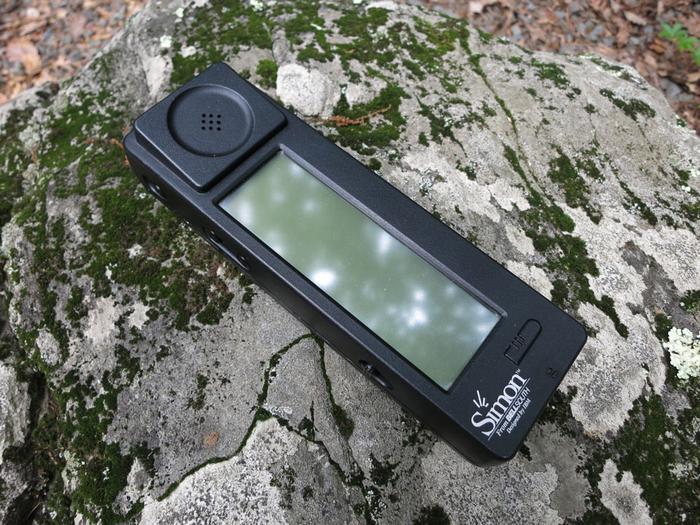
A bit of history
 Much later than those times when mammoths roamed the surface of our planet sadly, even before the release of the iPhone 5 and the announcement of Jelly Beans, humankind began to think about miniaturizing electronic devices so that they could carry them and serve as desktop computers.
Much later than those times when mammoths roamed the surface of our planet sadly, even before the release of the iPhone 5 and the announcement of Jelly Beans, humankind began to think about miniaturizing electronic devices so that they could carry them and serve as desktop computers.Around this time, IBM developed the first version of a smartphone called the IBM Simon, which first went on sale in August 1994. Directly engaged in the production of Mitsubishi Electric Corp.
The IBM Simon prototype, codenamed “Angler,” was unveiled at COMDEX in the fall of 1992. Even then, he was met by the public with a zametnym interest.
A total of 50,000 devices were sold. As far as I know, they were sold only in the USA through BellSouth Cellular. The price without a contract was $ 1099. With a two-year contract, the price was $ 899, which was later reduced to $ 599.
IBM Simon could receive faxes, emails, work as a pager (who remembers what it is - an orange), run embedded applications and just be a useful electronic assistant at a time when technology was just thinking of moving from dusty offices in the pockets of users.
')
In general, in the area of 1994, similar devices like Sony Magic Link , Motorola Marco , AT & T EO Personal Communicator were announced. But all of them were united by the fact that they were PDAs with built-in radio modems. At a time when IBM Simon was unique in that it was a phone with built-in PDA features.
Interestingly, the expression “smartphone” appeared later around 1997th, but functionally IBM Simon is considered the first smartphone.
Brief technical data
This wonderful phone had quite good parameters for that time:
- Vadem x86-compatible processor, 16 MHz, 16-bit
- Black and white touch screen with a resolution of 160x293
- OS: its own version of DOS, named ROM-DOS and released by Datalight
- 1 MB of RAM (approximately 640 KB is available)
- 1 MB flash for applications and data (compression is used, so the possible size was slightly larger)
- Built-in 2400 baud modem
- PCMCIA slot for memory and for expansion cards and applications
- Battery for about an hour of talk and 8-12 hours in standby mode
- Half a kilo of weight
Comparison
As without comparison? I decided to compare IBM Simon with the following devices (from left to right):
Samsung Galaxy Nexus, Apple iPhone 4, Wild Tribal Media (AKA Bob) and IBM Simon.
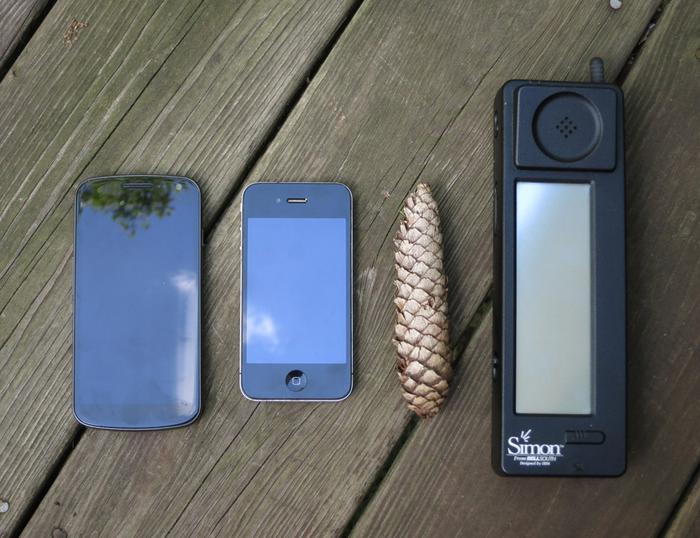
The same technique, but the side view (who will guess where which device will get the Bump as a gift from our sponsor):
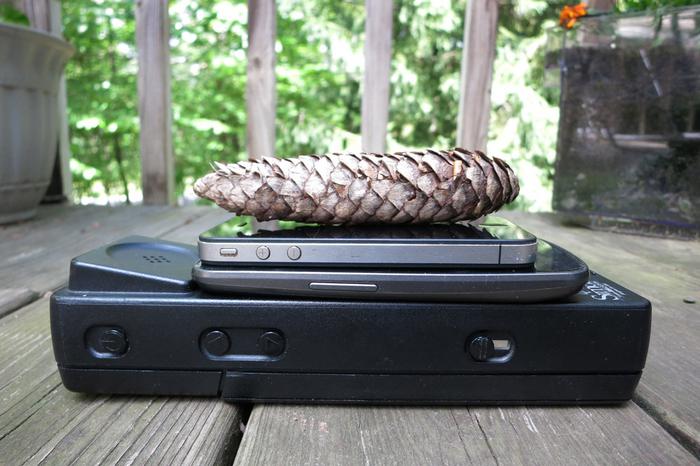
Disassembly
I am sure that it is not only me who has the weakness to disassemble and see what's inside of everything that comes into our hands, so let's move on to this fascinating process.
So, remove the battery and unscrew the four screws. Then remove the back cover:

Remove the protective screen:
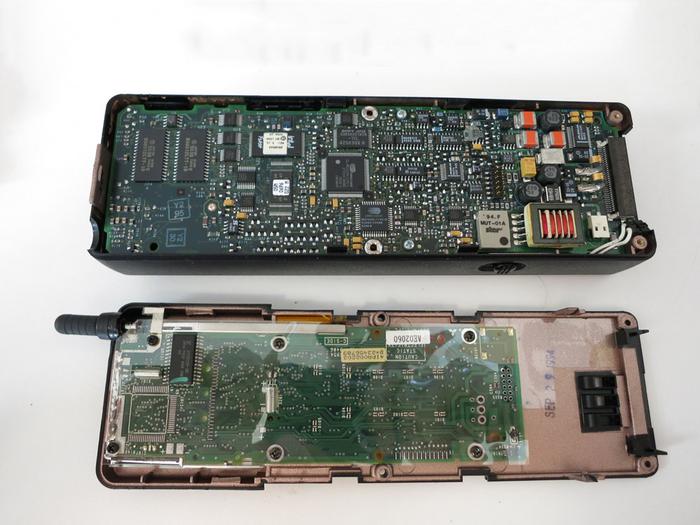
The phone is divided into two devices: the processor part (the top one in the photo) and the phone part (the bottom one in the photo).
Unfortunately, I could not find the right screwdriver to unscrew the antenna and therefore I couldn’t get deeper into the telephone part.
But on the other hand, I was able to get into the processor and, by unscrewing the board, you can see the opposite side with the central processor:

Our central processor Vadem VG-230:
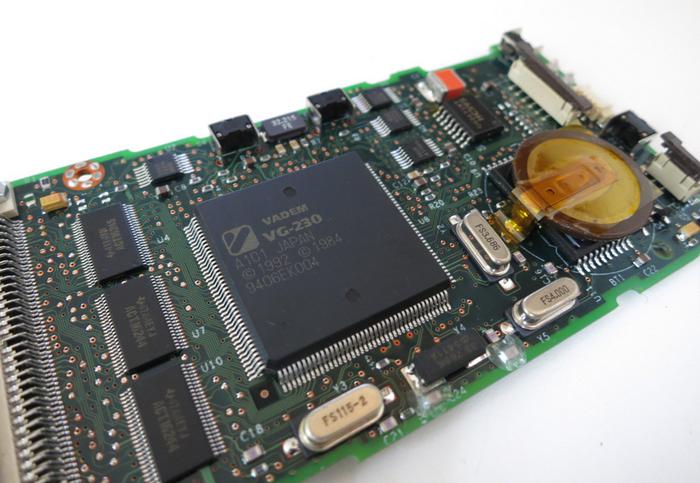
The Vadem VG230 chip is a single-crystal PC platform that contains all the necessary XT peripherals.
Vadem VG230 contains 8086-compatible NEC V30HL processor, clocked at 16 MHz.
This chip has a PCMCIA controller, a CGA LCD controller, a controller for stylus input, an XT keyboard, and more.
More technical information for those who are interested: Datasheet
By the way, there was an improved version of this processor in nature under the VG330 label, which is designed to operate at 32 MHz.
Here are clearly visible Cirrus Logic CL-MD1224 and CL-MD1624, which perform the functions of a modem at 2400 baud, as well as a fax up to 9600 baud.
The Sony CXK58257 is a 32 KB static RAM memory. Judging by the connection, it is used for the modem buffer.
Intel Flash and Hitachi Flash for user and DOS data are also clearly visible.

Two Hitachi 658512LTT-10 microcircuits are visible in the far corner. Each of them happily performs the functions of a pseudo-static memory of 512 KB. Together they organize 1 MB of RAM (about 640 KB are available to the user).
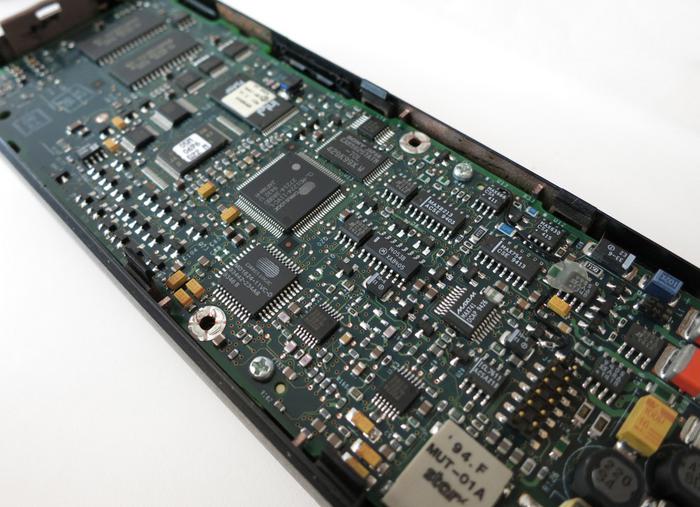
Afterword
In general, the assembly seemed to me very neat and sound. I still have very positive impressions when meeting this phone internally. Disassemble-assemble was easy, all components are available.
IBM Simon gives the impression of a certain ultra-beech when a full-featured computer is crammed into a minimum volume with some features like a small screen, no keyboard and so on.
Modern smartphones have long passed this step and are focused on maximum integration. For example, on modern smartphones, the telephone part no longer comes as a separate board, but is closely connected with the processor module.
Historically, IBM Simon, although it was released quite a short time, but he was undoubtedly one of the pioneers who determined the direction of development of mobile telephony and personal gadgets, to which we are already very accustomed.
Source: https://habr.com/ru/post/184490/
All Articles